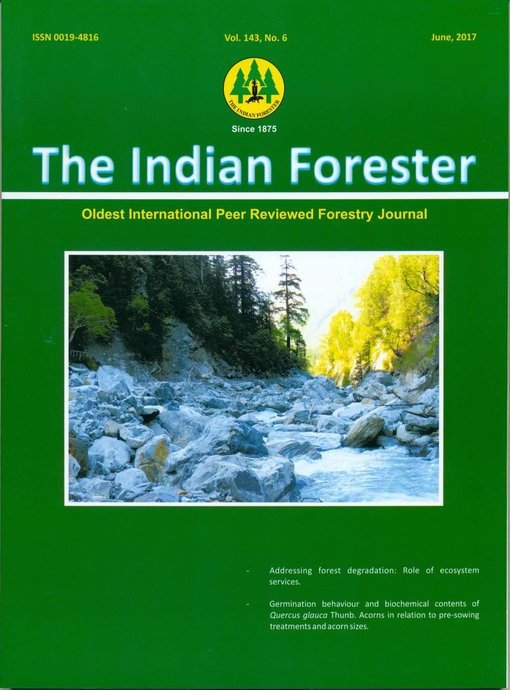Variation in Epiphytic Lichen Biomass Occurring on Quercus semecarpifolia Smith, Saplings at Two High Altitude Forests of Central Himalaya, India
DOI:
https://doi.org/10.36808/if/2017/v143i6/115829Keywords:
Anthropogenic Pressure, Commercial Lichens, Epiphytic Succession, Macrolichens, Uttarakhand.Abstract
Lichens have significant role in a forest ecosystem and are of considerable interest for forest management and climate studies. Altitude is an important factor which affects diversity, distribution and biomass of a species. The present study was carried out to assess the variation in epiphytic lichen biomass with increasing altitude. Authors have examined two high altitude forest sites of Uttarakhand, Central Himalaya for estimating quantitative biomass (dry mass) of epiphytic lichens occurring abundantly on Q. semecarpifolia (host). Both the forest sites were categorized into three altitudinal zones i.e. lower (2300-2400 m), middle (2400-2500 m) and upper (2500-2700 m). The macro lichens were harvested from different parts (bole, branch and twigs) of each selected sapling (n=54) across three altitudinal zones. The lichen biomass (g sapling-1) ranged from 64.0 ± 5 to 229.7 ± 4 and 159.7 ± 3 to 530.3 ± 4 at site A and B respectively. The number of lichen genera and biomass per sapling were strongly correlated with the altitude and the results showed that number of genera and biomass of lichens was increased with increasing altitude.References
Boucher V.L. and Nash T.H. (1990). The role of the fruticose lichen Ramalina menziesii in the annual turnover of biomass and macronutrients in a Blue Oak woodland. Botanical Gazette, 151:114-118.
Chaturvedi S.N. and Singh K.P. (2005). Plant Biodiversity Microbial Interaction and Environmental Biology, Jaipur.
Esseen P.A. (1985). Litter fall of epiphytic macrolichens in two old Picea abies forests in Sweden. Canadian J. Botany, 63:980-987.
Eversman S. (1982). Epiphytic lichens of a ponderosa pine Pinus ponderosa forest in southeastern Montana USA. Bryologist, 85:204–214.
Gauslaa Y., Lie M. and Ohlson M. (2008).Epiphytic lichen biomass in a boreal Norway spruce forest. The Lichenologist, 40 (3): 257-266.
Lehmkuhl J.F. (2004). Epiphytic lichen diversity and biomass in low-elevation forests of the eastern Washington Cascade range, USA. Forest Ecology and Management, 187: 381–392
McCune B. and Geiser L. (1997). Macrolichens of the Pacific Northwest. Oregon State University Press, Corvallis, USA.
Negi H.R. (1996).Usnealongissima-the winter staple food of musk deer: a case study from Musk Deer Breeding Center, Kanchulakharak in Garhwal Himalayas. Tiger Paper,23: 30-32.
Negi H.R. and Gadgil M. (1996). Patterns of distribution of macrolichens in western parts of Nanda Devi Biosphere Reserve. Current Science, 71 (7): 568-575.
Negi H.R. and Upreti D.K. (2000). Species diversity and relative abundance of lichens in Rumtek Catchment of Hemis National Park in Ladakh. Current Science,78: 1105-1112.
Odland A., Sandvik S.M., Bjerketvedt D.K. and Myrvold L.L. (2014). Estimation of lichen biomass with emphasis on reindeer winter pastures at Hardangervidda, S Norvey. Rangifer, 34 (1):95-110.
Peck J.E. and McCune B. (1997). Remnant trees and canopy lichen communities in Western Oregon: a retrospective approach. Ecological Applications, 7: 1181-1187.
Pike L.H. (1978).The importance of epiphytic lichens in mineral cycling.The Bryologist, 81(2): 247-57.
Pinokiyo A., Sing K.P. and Singh J.S. (2008). Diversity and distribution of lichens in relation to altitude within a protected biodiversity hot spot, north-east India. The lichenologist, 40 (1): 47-62.
Rawat S., Upreti D.K. and Singh R.P. (2011). Estimation of epiphytic lichen litterfall biomass in three temperate forests of Chamoli district, Uttarakhand, India. Topical ecology, 52(2):193-200.
Richardson D.H.S. and Hoksworth D.L. (1991).Lichens and man. International Mycological Institute, London.
Upreti D.K., Uniyal P.C., Chamola B.P. and Semwal B.P. (2010). Lichen diversity of Uttarakhand Himalaya: Plant wealth of Uttarakhand. New Delhi.
Downloads
Downloads
Published
How to Cite
Issue
Section
License
Unless otherwise stated, copyright or similar rights in all materials presented on the site, including graphical images, are owned by Indian Forester.





